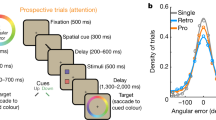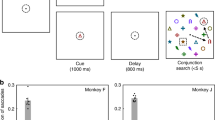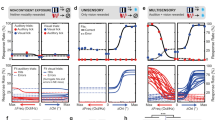Abstract
Visual attention is guided to stimuli either on the basis of their intrinsic saliency against their background (bottom-up factors) or through willful search of known targets (top-down factors). Posterior parietal cortex (PPC) is thought to be important for the guidance of visual bottom-up attention, whereas dorsolateral prefrontal cortex is thought to represent top-down factors. Contrary to this established view, we found that, when monkeys were tested in a task requiring detection of a salient stimulus defined purely by bottom-up factors and whose identity was unknown before the presentation of a visual display, prefrontal neurons represented the salient stimulus no later than those in the PPC. This was true even though visual response latency was shorter in parietal than in prefrontal cortex. These results suggest an early involvement of the prefrontal cortex in the bottom-up guidance of visual attention.
This is a preview of subscription content, access via your institution
Access options
Subscribe to this journal
Receive 12 print issues and online access
$209.00 per year
only $17.42 per issue
Buy this article
- Purchase on Springer Link
- Instant access to full article PDF
Prices may be subject to local taxes which are calculated during checkout








Similar content being viewed by others
References
Bisley, J.W. & Goldberg, M.E. Attention, intention, and priority in the parietal lobe. Annu. Rev. Neurosci. 33, 1–21 (2010).
Schall, J.D. The neural selection and control of saccades by the frontal eye field. Phil. Trans. R. Soc. Lond. B 357, 1073–1082 (2002).
Noudoost, B., Chang, M.H., Steinmetz, N.A. & Moore, T. Top-down control of visual attention. Curr. Opin. Neurobiol. 20, 183–190 (2010).
Connor, C.E., Egeth, H.E. & Yantis, S. Visual attention: bottom-up versus top-down. Curr. Biol. 14, R850–R852 (2004).
Corbetta, M. & Shulman, G.L. Control of goal-directed and stimulus-driven attention in the brain. Nat. Rev. Neurosci. 3, 201–215 (2002).
Ungerleider, L.G. & Mishkin, M. Two cortical visual systems. in Analysis of Visual Behavior (eds. Ingle, D.J., Goodale, M.A. & Mansfield, R.J.W.) 549–586 (MIT Press, 1982).
Felleman, D.J. & Van Essen, D.C. Distributed hierarchical processing in the primate cerebral cortex. Cereb. Cortex 1, 1–47 (1991).
Serre, T., Oliva, A. & Poggio, T. A feedforward architecture accounts for rapid categorization. Proc. Natl. Acad. Sci. USA 104, 6424–6429 (2007).
Buschman, T.J. & Miller, E.K. Top-down versus bottom-up control of attention in the prefrontal and posterior parietal cortices. Science 315, 1860–1862 (2007).
Kustov, A.A. & Robinson, D.L. Shared neural control of attentional shifts and eye movements. Nature 384, 74–77 (1996).
Moore, T. & Fallah, M. Control of eye movements and spatial attention. Proc. Natl. Acad. Sci. USA 98, 1273–1276 (2001).
Constantinidis, C. & Steinmetz, M.A. Neuronal responses in area 7a to multiple stimulus displays. I. Neurons encode the location of the salient stimulus. Cereb. Cortex 11, 581–591 (2001).
Schall, J.D. & Hanes, D.P. Neural basis of saccade target selection in frontal eye field during visual search. Nature 366, 467–469 (1993).
Preuss, T.M. & Goldman-Rakic, P.S. Myelo- and cytoarchitecture of the granular frontal cortex and surrounding regions in the strepsirhine primate Galago and the anthropoid primate Macaca. J. Comp. Neurol. 310, 429–474 (1991).
Badre, D. & D'Esposito, M. Is the rostro-caudal axis of the frontal lobe hierarchical? Nat. Rev. Neurosci. 10, 659–669 (2009).
Sato, T.R., Watanabe, K., Thompson, K.G. & Schall, J.D. Effect of target-distractor similarity on FEF visual selection in the absence of the target. Exp Brain Res 151, 356–363 (2003).
Treisman, A.M. & Gelade, G. A feature-integration theory of attention. Cognit. Psychol. 12, 97–136 (1980).
Wolfe, J.M. Guided Search 2.0. A revised model of visual search. Psychon. Bull. Rev. 1, 202–238 (1994).
Itti, L. & Koch, C. Computational modeling of visual attention. Nat. Rev. Neurosci. 2, 194–203 (2001).
Knierim, J.J. & van Essen, D.C. Neuronal responses to static texture patterns in area V1 of the alert macaque monkey. J. Neurophysiol. 67, 961–980 (1992).
Hegdé, J. & Felleman, D.J. How selective are V1 cells for pop-out stimuli? J. Neurosci. 23, 9968–9980 (2003).
Burrows, B.E. & Moore, T. Influence and limitations of popout in the selection of salient visual stimuli by area V4 neurons. J. Neurosci. 29, 15169–15177 (2009).
Koch, C. & Ullman, S. Shifts in selective visual attention: towards the underlying neural circuitry. Hum. Neurobiol. 4, 219–227 (1985).
Niebur, E. & Koch, C. Control of selective visual attention: modeling the “where” pathway. in Neural Information Processing Systems (eds. Touretzky, D.S., Mozer, M.C. & Hasselmo, M.E.) 802–808 (MIT Press, 1996).
Katsuki, F. & Constantinidis, C. Unique and shared roles of the posterior parietal and dorsolateral prefrontal cortex in cognitive functions. Front. Integr. Neurosci. 6, 17 (2012).
Gottlieb, J.P., Kusunoki, M. & Goldberg, M.E. The representation of visual salience in monkey parietal cortex. Nature 391, 481–484 (1998).
McPeek, R.M. & Keller, E.L. Saccade target selection in the superior colliculus during a visual search task. J. Neurophysiol. 88, 2019–2034 (2002).
Thomas, N.W. & Pare, M. Temporal processing of saccade targets in parietal cortex area LIP during visual search. J. Neurophysiol. 97, 942–947 (2007).
Thompson, K.G., Hanes, D.P., Bichot, N.P. & Schall, J.D. Perceptual and motor processing stages identified in the activity of macaque frontal eye field neurons during visual search. J. Neurophysiol. 76, 4040–4055 (1996).
Wardak, C., Vanduffel, W. & Orban, G.A. Searching for a salient target involves frontal regions. Cereb. Cortex 20, 2464–2477 (2010).
Cavada, C. & Goldman-Rakic, P.S. Posterior parietal cortex in rhesus monkey. II. Evidence for segregated corticocortical networks linking sensory and limbic areas with the frontal lobe. J. Comp. Neurol. 287, 422–445 (1989).
Constantinidis, C. Posterior parietal mechanisms of visual attention. Rev. Neurosci. 17, 415–427 (2006).
Arcizet, F., Mirpour, K. & Bisley, J.W. A pure salience response in posterior parietal cortex. Cereb. Cortex 21, 2498–2506 (2011).
Premereur, E., Vanduffel, W. & Janssen, P. Functional heterogeneity of macaque lateral intraparietal neurons. J. Neurosci. 31, 12307–12317 (2011).
Bichot, N.P., Schall, J.D. & Thompson, K.G. Visual feature selectivity in frontal eye fields induced by experience in mature macaques. Nature 381, 697–699 (1996).
Constantinidis, C. & Steinmetz, M.A. Posterior parietal cortex automatically encodes the location of salient stimuli. J. Neurosci. 25, 233–238 (2005).
Meyer, T. & Constantinidis, C. A software solution for the control of visual behavioral experimentation. J. Neurosci. Methods 142, 27–34 (2005).
Brainard, D.H. The Psychophysics Toolbox. Spat. Vis. 10, 433–436 (1997).
Cavada, C. & Goldman-Rakic, P.S. Posterior parietal cortex in rhesus monkey. I. Parcellation of areas based on distinctive limbic and sensory corticocortical connections. J. Comp. Neurol. 287, 393–421 (1989).
Harris, K.D., Henze, D.A., Csicsvari, J., Hirase, H. & Buzsaki, G. Accuracy of tetrode spike separation as determined by simultaneous intracellular and extracellular measurements. J. Neurophysiol. 84, 401–414 (2000).
White, B.J. & Munoz, D.P. Separate visual signals for saccade initiation during target selection in the primate superior colliculus. J. Neurosci. 31, 1570–1578 (2011).
Davison, A.C. & Hinkley, D.V. Bootstrap Methods and Their Application (Cambridge University Press, 1997).
Rowland, B.A., Quessy, S., Stanford, T.R. & Stein, B.E. Multisensory integration shortens physiological response latencies. J. Neurosci. 27, 5879–5884 (2007).
Tolhurst, D.J., Movshon, J.A. & Dean, A.F. The statistical reliability of signals in single neurons in cat and monkey visual cortex. Vision Res. 23, 775–785 (1983).
Dayan & Abbott, L.F. Theoretical Neuroscience: Computational and Mathematical Modeling of Neural Systems (The MIT Press, 2001).
Acknowledgements
We wish to thank K. Palaninathan, K. Roberts and J. Rawley for helping with the experiments, and R. Ramachandran, T. Stanford and E. Salinas for comments. This work was supported by the National Eye Institute of the US National Institutes of Health under award number R01 EY016773 and by the Tab Williams Family Endowment Fund.
Author information
Authors and Affiliations
Contributions
F.K. and C.C. designed the experiments. F.K. performed the experiments. F.K. and C.C. analyzed the data and wrote the paper.
Corresponding author
Ethics declarations
Competing interests
The authors declare no competing financial interests.
Supplementary information
Supplementary Text and Figures
Supplementary Figures 1–10 (PDF 6450 kb)
Rights and permissions
About this article
Cite this article
Katsuki, F., Constantinidis, C. Early involvement of prefrontal cortex in visual bottom-up attention. Nat Neurosci 15, 1160–1166 (2012). https://doi.org/10.1038/nn.3164
Received:
Accepted:
Published:
Issue Date:
DOI: https://doi.org/10.1038/nn.3164
This article is cited by
-
Conflict detection and resolution in macaque frontal eye fields
Communications Biology (2024)
-
Neural evidence for attentional capture by salient distractors
Nature Human Behaviour (2024)
-
Task-specific modulation of PFC activity for matching-rule governed decision-making
Brain Structure and Function (2021)
-
Connectivity between nidopallium caudolateral and visual pathways in color perception of zebra finches
Scientific Reports (2020)
-
Reward uncertainty asymmetrically affects information transmission within the monkey fronto-parietal network
Communications Biology (2020)



